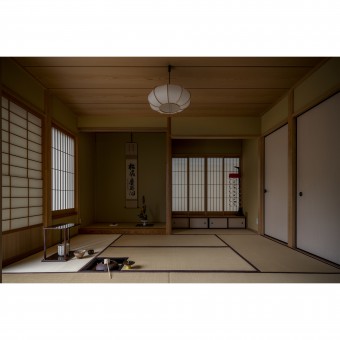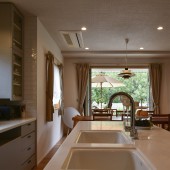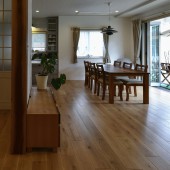Sado Residential House by Akinori Dansako |
Home > Winners > #78421 |
 |
|
||||
| DESIGN DETAILS | |||||
| DESIGN NAME: Sado PRIMARY FUNCTION: Residential House INSPIRATION: Akinori Dansako's concept of design is based on creating welcoming feelings for all people. Mr Dansako aims to make it easier for friends and family to cook together, eat together, spend time together and laugh and relax in comfortable spaces. Mr Dansako's relaxing spaces create an ambience that is conducive to friends and families relaxing and sometimes dozing on the tatami mat. Tatami mats are a famous Japanese floor covering, usually made from rice straw. Tatami mats have a soft covering and are always made in a standard size. The length is always twice the width. UNIQUE PROPERTIES / PROJECT DESCRIPTION: Mr Dansako's approach to design in the SADO house is influenced by Mr Sen No Rikyu, the famous Japanese inventor of the tea ceremony. Sen No Rikyu’s tea ceremony concept is not complicated: boil water, serve the customer and enjoy drinking the tea yourself as well. It is a very simple process, but refined and wonderful. Akinori has taken Mr Sen No Rikyu’s approach when he designs a house. He loves to create simple living spaces often with a tea room and central pillar and influenced from traditional Japanese techniques. The end results are simple, welcoming and light filled spaces. OPERATION / FLOW / INTERACTION: Akinori's SADO house design lifts the spirits - it is light filled, and yet private. Sustainability is central to Akinori's ethos. Waste is minimised in the design stage wherever possible Akinori ensures the dimensions of key building components are standard sizes. This is especially important where rooms have tatami mat flooring - the room dimensions must allow the fitting of an exact number of tatami mats so there are no gaps in floor covering. Windows are also standard sized wherever possible. By orienting the house towards the south, sun light is maximised. Cross ventilation is used to maximise the coastal breezes and maintain pleasant and cool living spaces. Whilst central heating is a key part of the project, the careful orientation of the house reduces the need to use air conditioning. All exterior walls in the SADO house are insulated with earthquake resistant extruded polystyrene foam. This has huge energy benefits for the owners in Japan's environment, which features sub-zero winters and very hot and humid Summers. PROJECT DURATION AND LOCATION: The design stage of the project started in April 2015 and was completed in June 2016, including approvals from the Prefecture Council. The construction stage commenced in August 2016 and was completed by April 2017. The project was located in OKAYAMA JAPAN, about 180km from Osaka on Japan's largest island Honshu. FITS BEST INTO CATEGORY: Interior Space and Exhibition Design |
PRODUCTION / REALIZATION TECHNOLOGY: Akinori always tries to connect living, dining, kitchen and tea room spaces into one functional room. This is important in the parts of Japan Akinori works mostly in Okayama Prefecture. Here, like in many parts of Japan, space is limited and people usually have small houses less than 200m2. Akinori loves designing contemporary spaces using an intriguing mix of modern steel and glass with traditional Japanese style materials particularly raw timber and tatami mats. Akinori has a hands on approach to architecture once he has completed the design and secured all the approvals, Akinori then works closely with builders to ensure his design is created to his precise design. He spends up to 10 hours a day on building sites even using his practical skills to help the builder. The outcome must be seen to be believed if a measurement is more than 1 mm out, Akinori will see that's it corrected. SPECIFICATIONS / TECHNICAL PROPERTIES: The site area of the SADO house was 435m2. The ground floor area was 114.26m2, first floor area 83.43m2 and total living area a meagre 197.69m2. The intricate timber framework method of construction is outlined above. However the key timbers used in the SADO house include Japanese cedar, douglas fir and cypress pine. Veneer cladded laminated structural beams provide both natural textures, but importantly, earthquake resistance. TAGS: Architect, House,Japan,Tatami,I RESEARCH ABSTRACT: - CHALLENGE: Like many Japanese architects, Mr Dansako is constantly thinking about the ever present challenge of designing buildings that can withstand earthquakes and tremors. Mr Dansako approach was to use strong Japanese cedar and cypress pine as the key framing timbers. These timbers have excellent earthquake resistance properties, especially when integrated with high tensile metal fasteners and joiners. Another significant challenge was to meet the owner's request for an energy efficient house that could cope with Japan's long cold Winters and its hot Summers. The key design feature to tackle this challenge was the innovative use of extruded ceramic exterior walls. These prefabricated walls are designed to allow warm air to rise through a special channel inside the prefabricated wall. This air then flows into the ceiling cavity of the house during Summer and escapes, thereby cooling the SADO house without the use of energy. During Winter the wall channels can be closed with a switch to capture the warm air. ADDED DATE: 2019-02-24 03:51:30 TEAM MEMBERS (1) : AKINORI DANSAKO. Akinori runs a small architecture business in the beautiful Japanaese city of Kurashiki, which is about 180km from Osaka on Japan's main Island Honshu. IMAGE CREDITS: Photographer Senichiro Nogami |
||||
| Visit the following page to learn more: https://www.instagram.com/t.a.d_architec |
|||||
| AWARD DETAILS | |
 |
Sado Residential House by Akinori Dansako is Winner in Interior Space and Exhibition Design Category, 2018 - 2019.· Read the interview with designer Akinori Dansako for design Sado here.· Press Members: Login or Register to request an exclusive interview with Akinori Dansako. · Click here to register inorder to view the profile and other works by Akinori Dansako. |
| SOCIAL |
| + Add to Likes / Favorites | Send to My Email | Comment | Testimonials | View Press-Release | Press Kit |
Did you like Akinori Dansako's Interior Design?
You will most likely enjoy other award winning interior design as well.
Click here to view more Award Winning Interior Design.








